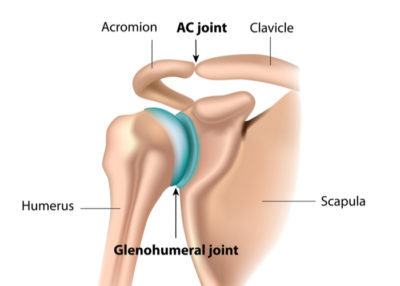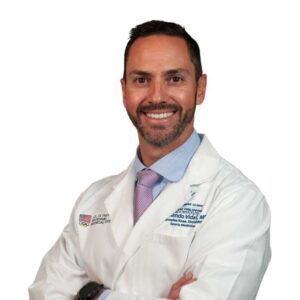What is the AC Joint?
The AC joint, also known as the Acromioclavicular Joint, is one of the four joints that make up the shoulder complex. It is the area where the clavicle (collarbone) attaches to the top, or “roof” of the shoulder, called the acromion. This is located on the shoulder, away from the neck, toward the arm. The AC joint is stabilized by the AC capsule and 2 stout coraclavicular ligaments – the conoid and the trapezoid. If the shoulder sustains an impact or force directly, or indirectly, the AC joint and it’s supporting ligaments can be separated or moved from their normal anatomical position. Dr. Armando Vidal, orthopedic shoulder surgeon serving Vail, Aspen and the surrounding Denver, Colorado communities, specializes in AC joint reconstruction and repair.

What is an AC joint separation?
One of the most common causes of shoulder pain, especially in young athletes is an AC joint separation. Most AC joint injuries result from high-impact sports, such as football, hockey or wrestling. It can occur when a traumatic force causes the collarbone and the roof of the shoulder to move away from each other, pulling or tearing the ligaments so they no longer hold the bones in their correct position. Acromioclavicular joint injuries can also occur with a serious fall or accident.
Is there a difference between AC shoulder separation and shoulder dislocation?
Both AC shoulder joint separations and shoulder dislocations involve the bones in the shoulder that move away from their correct position, either partially or completely. The main difference is the location within the shoulder where the ligaments are pulled or torn. If the glenohumeral joint (ball and socket joint of the shoulder) comes out of the socket, either partially or completely, this is called a shoulder dislocation. However, if the injury occurs in the AC joint, it is called a shoulder separation. It is important to see an experienced shoulder surgeon like Dr. Armando Vidal who has a proven track record for helping patients with shoulder dislocations and AC shoulder separations.
Are there different types of AC shoulder separation?
Dr. Vidal measures AC joint separations depending on their severity:
- Type 1 – Commonly caused by a sprain or the stretching of the ligament, causing pain and discomfort. There is usually some mild swelling over the joint, but no deformity.
- Type 2 – Partial separation of the AC joint. One of the ligaments, called the coracoclavicular (CC) ligament is intact, but the AC ligament is completely torn. This results in minor visible deformity.
- Type 3 – Complete separation where both the AC ligament and the CC ligaments are torn. Also, in most cases involves the joint capsule being torn.
- Grades 4, 5 and 6 are very rare and include the rupture or tearing of the AC and CC ligament as well as the shoulder capsule, deltoid muscle and trapezius muscle. Injuries of this nature require reconstructive surgery.
Why would AC joint reconstruction be needed?
AC joint separations that are severe can cause instability, muscle fatigue, scapular instability and neurological problems due to the injury. Patients with high grade injuries or failure of conservative management for lower grade injuries should consider joint reconstruction. AC joint reconstruction is a preferred treatment to restore the joint to its stable and strong supportive function. The goal of AC joint reconstruction is to bring the CC and AC ligaments as close to their native anatomical locations as possible. The most common surgical option for AC joint repair is coracoclavicular ligament reconstruction.
How do they do AC joint reconstruction?
The goal of AC joint reconstruction is to secure the clavicle back to its normal position by attaching strong sutures to the clavicle and to the front of the shoulder blade. Dr. Vidal can perform this surgery arthroscopically, using a small camera inserted into the shoulder through a small incision to “see” inside the shoulder. Small instruments are inserted through other tiny incisions on the top of the shoulder and the surgery is completed inside the shoulder. In cases of significant damage, Dr. Vidal will reconstruct the coracoclavicular ligaments (CC) by looping the donated graft, called an allograft, from the front of the shoulder blade to the top of the collarbone. This can also be performed with an artificial “ligament” in some cases. In rare cases, a plate will be attached to help the bone heal correctly and is then removed once the joint has mended.
What is the recovery like after AC joint reconstruction?
AC joint reconstruction and repair is usually performed on an outpatient basis. Patients can expect the following:
- A sling is worn for several weeks to protect the joint.
- Full range of motion is quickly re-established within days following surgery with passive and then active motion exercises as advised by Dr. Vidal.
- After the ligaments have healed, strength exercises can begin and the patient may remove the arm sling.
- Return to sporting activities is typically 4-6 months after surgery.
AC Joint Restoration Surgeon
Are you an athlete participating in high-impact sports? If so, you are at risk of experiencing an AC joint injury or separation. These injuries vary in severity, however the more severe injuries can cause neurological damage if left untreated. Arthroscopic shoulder surgeon, Doctor Armando Vidal has diagnosed and treated patients in Vail, Aspen, and the surrounding Denver, Colorado communities who have experienced a shoulder trauma resulting in frequent pain and weakness. Contact Dr. Vidal’s team today!

Locations
180 S Frontage Rd W
Vail, CO 81657
226 Lusher Court
Ste 101
Frisco, CO 80443
322 Beard Creek Road
Edwards, CO 81632


